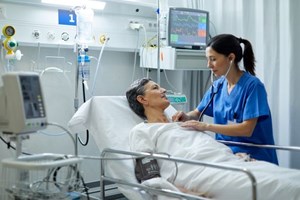
Letter from the Chair
by Thom Mitchell, MD
I just survived the first ACEP virtual Council meeting October 24 - 25, 2020. There were 443 eligible councilors and 434 participated from their homes or offices on a virtual platform. Leslie Mukau, MD, FACEP, served for the councillor for the Emergency Medicine Workforce Section. Recall, during council we review resolutions and modify, accept, reject, or refer to the board the resolutions. One member may submit a resolution, however, most come from state chapters, specialty chapters or other bodies within ACEP. There were 55 resolutions submitted. The resolutions are each reviewed by one of three Reference Committees (Governance and Membership, Advocacy and Public Policy, and Emergency Medicine Practice). The Committees hear testimony generally from the author, ACEP officials and councillors in favor or not in favor of the resolutions and/or recommendations for modifications. Occasionally two similar resolutions may be combined. The Reference Committees then each develop a summary report reflecting the content of the testimony and making recommendations regarding adoption, rejection, or referral to the board for each resolution. This year the testimony to the Reference Committees was electronic and asynchronous. It took place for eight days ending three days prior to the start of Council. For two days we discussed and voted on the resolutions on a virtual platform. You can imagine in that environment there as a lot of the title of this document. The Council Speaker and Vice-Speaker did an outstanding job guiding the meeting and making adjustments in response to electronic foibles. I would like to summarize some of the more interesting resolutions.
Resolution 21, submitted by the California and Wisconsin chapters, requested that ACEP become a member of the Medical Society Consortium on Climate and Health. Furthermore, it requested that ACEP support one ACEP member (by covering expenses) to attend the annual meeting of this organization. This was approved. Apparently other physician professional organizations are members.
Resolution 36, submitted by the Louisiana Chapter and the Emergency Telehealth Section, requested that ACEP in collaboration with other medical organizations, advocate for universal access to telehealth care through expanded broadband infrastructure and wireless connectivity to all rural and underserved areas of the United States as well as supporting innovative strategies to improve individual access to broadband and cellular technology. This was adopted.
Resolution 39, submitted by two individuals requested that ACEP join the American Academy of Ophthalmology in condemning the use of rubber bullets and tear gas to control or disperse crowds and calling on all law enforcement officials to permanently and immediately end these practices. There was lively discourse on this, in particular questioning how often law enforcement tells us what to do. This was not adopted.
Resolution 44, submitted by two individuals, requested that ACEP adopt a policy stating, “No member of ACEP will, directly or indirectly, deny other emergency physicians the right to due process regarding their medical staff privileges and ability to see patients in an emergency department”. Furthermore, it requested that ACEP modify the existing policy statement “Emergency Physician Rights and Responsibilities” to include that emergency physicians shall be accorded due process before any adverse final action takes place. This was referred to the Board.
Resolution 45, submitted by the Louisiana Chapter and the Emergency Telehealth Section, requested that ACEP create new or reaffirm policy that supports that all states and US territories waive standard licensing requirements for emergency physicians to provide their services, in any state or territory once a disaster has been declared. As well it requested that emergency physicians practicing in that environment be provided immunity and holding them harmless for services provided. This was referred to the Board.
Resolution 47, submitted by (Emergency Medicine Residents’ Association EMRA) and the Pennsylvania Chapter, requested that ACEP partner with EMRA to encourage all employers to honor their employment contracts with graduating emergency medicine resident physicians. In the discussion I learned that this is a problem! This was adopted.
Resolution 49, submitted by Forensic Medicine Section and six individuals, started as a statement regarding intimate partner violence and recommendations regarding law enforcement behavior. After asynchronous testimony and public discussion, it morphed to requesting that ACEP acknowledge the hazard associated with air-choke holds, strangulation, and carotid restraint. Furthermore, that ACEP educate its members and relevant stakeholders on the hazards and the recognition and appropriate management of patents who present to the emergency department (ED) with such injuries. This was approved.
Marc Rosenberg, DO, FACEP, was installed as the new ACEP President. Elections were held and the incumbent Board Members, Alison Haddock, MD, FACEP; and Aisha T. Terry, MD, FACEP, were reelected. As well, your new board members are James Shoemaker, MD, FACEP; and Arvind Venkat, MD, FACEP. Our new President-Elect is Gillian Schmitz, MD, FACEP.
I continue to find this to be an interesting and valuable meeting. I am able to learn what the membership considers to be the pressing issues. To a large extent this meeting guides the direction of the American College of Emergency Physicians. We are hoping this will be a live meeting next year in Boston October 23 and 24, 2021. I believe asynchronous virtual Reference Committee testimony is here to stay. If you have an interest in serving as a councillor or alternate councillor please contact your state chapter or me.
Thom R. Mitchell, MD, FACEP
Chair, Emergency Medicine Workforce Section
Tmitch1053@aol.com



